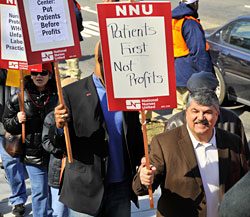Still Paying Through the Nose,
Labor Campaigns for Single Payer
By Andy Coates
Health Care NOW via Labor Notes
June 9, 2011 - A year after President Obama signed his health care reform with strong support from the labor movement, advocates of a single-payer system might be tempted to ask, “How’s that working out for you?”
At last weekend’s conference of the Labor Campaign for Single Payer, a Plumbers and Pipe Fitters delegate pointed out that his members are paying $12.31 per hour for their health benefits.
The activists marshaled their forces once again in D.C. last weekend, where campaign coordinator Mark Dudzic reported progress on the group’s mission: “to establish and expand within labor the idea that labor has got to lead this fight” for single payer, or improved and expanded Medicare-for-All.
Indeed, the conference began June 3 at AFL-CIO headquarters and heard from President Richard Trumka himself. Trumka spoke of the reluctance of the AFL-CIO Executive Council to embrace single payer but pointed to disappointment with the president’s Affordable Care Act at the council.
He recalled meetings 20 years ago when he fought for single payer on the council and Karen Ignagni, then assistant to the AFL-CIO president, was “doing her damnedest” to thwart the effort. (Today Ignagni is CEO of America’s Health Insurance Plans, the lead lobby for health insurance corporations.)
Trumka referred to single payer as “the only way to cure the health care problem.” He proposed that labor should “continue to educate about Canada. It’s a big myth about Canada. I go there all the time. You sit down with someone over coffee and ask them: ‘Tell me about your health care.’ They say: ‘Oh, it’s a godsend.’ We need to get that message out.”
The AFL-CIO president also continued to gesture toward political independence for labor, saying, “We should strengthen our support for our friends and do less for our acquaintances.”
As signs of progress, Dudzic noted the federation’s financial support for the Labor Campaign, participation by Vice President Arlene Holt Baker in a press conference announcing single-payer legislation, and the fact that the AFL-CIO sent staffer Nick Unger to help the single-payer efforts in Vermont. (Unger was the same staffer who in 2009-2010 campaigned for single-payer activists to embrace the public option.)
Dudzic also reported progress within the Labor Caucus for Single Payer, a group of nine internationals chaired by Greg Junemann of the Professional and Technical Engineers. Dudzic suggested several unions in which single-payer activists should “insist that our leaders follow the direction of the members.”
Without the White House
The deafening silence coming from the White House was a recurring theme as participants discussed the state-by-state assault on labor, ongoing unemployment, and the relentless rise in the costs of care. Stuart Acuff of the Utility Workers counseled, “Our job is not to follow Obama. Our job is to hold Obama accountable.”
Although the chances of passing a single-payer bill this year are less than remote, delegates welcomed Representative Jim McDermott of Washington by conference call and Representatives John Conyers and Dennis Kucinich, co-sponsors of HR 676, in person. HR 676, which calls for a publicly financed, privately delivered health care system, has been introduced every year since 2003.
McDermott, a psychiatrist, recently introduced a single-payer House companion to one introduced by Senator Bernie Sanders of Vermont.
Delegates agreed to support both the McDermott and Conyer bills, yet took note that HR 676 covers the undocumented, forces for-profit hospitals to convert to non-profit status, and requires federal, instead of state-by-state, administration.
On more immediate efforts in the states, delegates heard a panel from Vermont, where the Act for a Universal and Unified Health System was signed into law May 26. Mari Cordes of the Vermont Nurses/AFT recalled that only two years ago single-payer advocates were called “bomb throwers” by Vermont legislators for sticking to a cause labeled “too hard” and “not possible.”
Jill Charbeonneau, president of the Vermont AFL-CIO, cautioned that the legislation was the first in a series of steps toward single payer—”a skeleton this year,” followed by a year-long process of defining the scope of health benefits under the plan, followed by a second to third year process “to decide how to finance the system,” and ultimately a need for waivers from the federal government.
A video excerpt from the Vermont Workers Center illustrated the grassroots campaign, predicting: “If Vermont Leads, the Rest of the Nation Will Follow.” On a panel about the effort in California, Cindy Young of the California Nurses Association laid out a multi-year strategy for achieving single payer in that state.
Don Tremontozzi, a local president who is running for the No. 2 job in the Communications Workers national union, described how his members phone-banked for single payer in Vermont this spring.
“Once it was, ‘I want what the unions have,’” Trementozzi said. “Now it’s, ‘Why should you have 100 percent coverage?’ We need to get to the public.”
He roused the room with a call to defend the existing benefits companies are trying to claw back.
Drawing parallels between his union’s upcoming contract negotiations with Verizon and talks now under way with General Electric, Trementozzi said, “Yesterday at the CWA headquarters Verizon made a presentation about how costly health care is. These companies make billions in profits! They pay their CEOs millions!”
Trementozzi said “these companies act like they make no money at all” when they come crying to jack up insurance rates and cut health benefits for retirees.
“I say, ‘Over my dead body!’” Trementozzi said. “When a company makes billions and pays no taxes—we won’t stand for it!”



![[PDA - Heathcare NOT Warfare - Sign the Petition.]](http://pdamerica.org/images/ads/HealthNotWar_final.jpg)



No comments:
Post a Comment